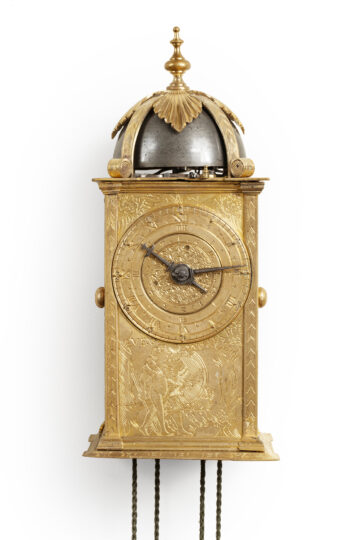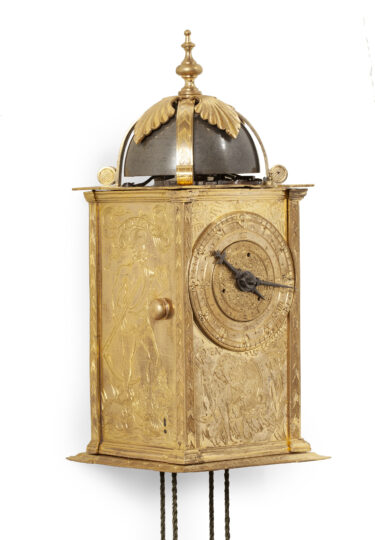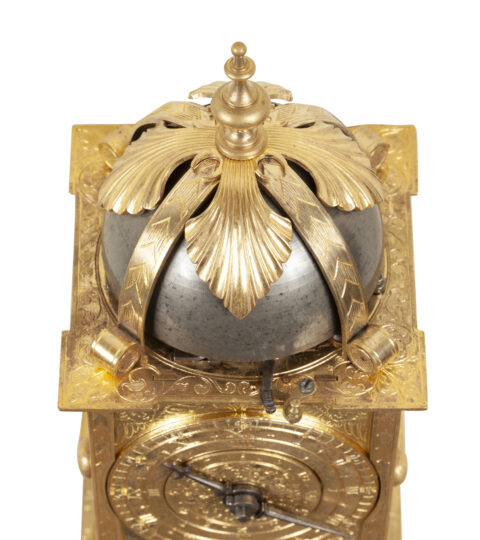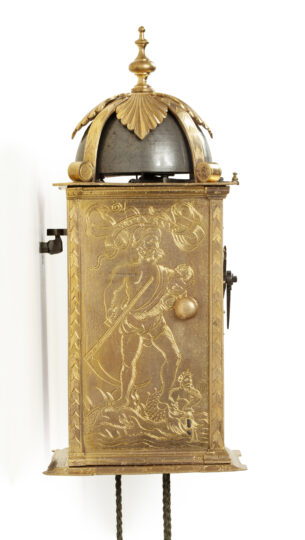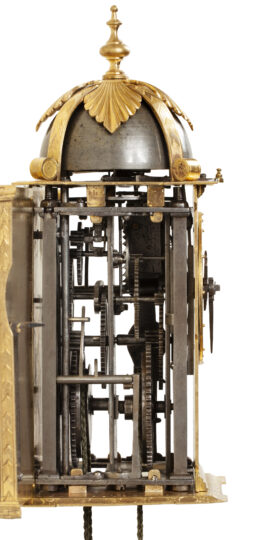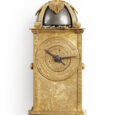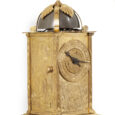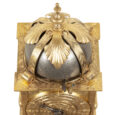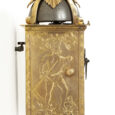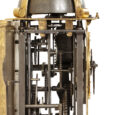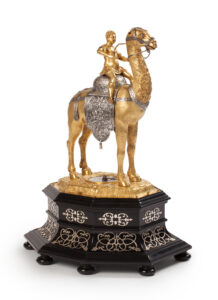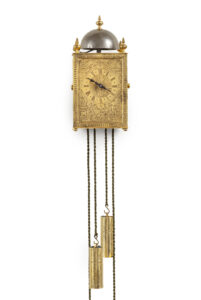RENAISSANCE WEIGHT-DRIVEN TÜRMCHENUHR Ca. 1580 South-Germany
M&R214
RARE WEIGHT-DRIVEN TÜRMCHENUHR
With striking and alarm
Circa 1580
South-Germany
Movement
The lead-weight driven iron movement is constructed between vertical bars and consists of going and striking trains, as well as an alarm. The going train has a vertical verge escapement with balance wheel. The striking indicates the hours fully on a bell. The alarm is spring-driven.
Dial
The circular, firegilt dial has the following rings from the outside to the inside: a narrow minute ring with Arabic numerals to indicate every five minutes, with touch pins for each quarter hour; the next ring with Roman hour numerals and half-hour divisions in the shape of a cross. The hour numerals have touch pins, so that the time can be ascertained in the dark. The inner ring has Roman quarter-hour and 7½-minute divisions. There is an engraved alarm disc with Arabic hour numerals in the middle behind the hands, the alarm time being indicated by the tail of the hour hand. The time is indicated by two forged steel hands.
Case
The front and sides of the firegilt brass case are beautifully engraved. The words Ven and Mars are engraved in the front with below an image of Venus embraced by Mars. There are two putti in the top corners, whilst the corners are embellished by engraved rectangular pillars. The sides panels including the corner pillars serve as doors. The left one shows an engraved Saturn, in the right door Spes (Hope) is engraved. The alarm is wound through a hole in the right door. The bell is mounted on top of the clock in an engraved bell strap embellished by sculpted leaves and surmounted by a turned finial. There is a slide at the front of the top plate under the bell with which the alarm can be switched on and off.
Duration: 5 days.
Height: 21 cm.
Width: 8.5 cm.
Depth: 8.5 cm.
Literature: Hall’s Dictionary of Subject & Symbols in Art, pp. 200, 256, 272-73, 318, 349.
Mars
Mars (Greek Ares) is the god van war, one of the twelve Olympians. His brutal and aggressive nature made him hated by nearly everyone, including his parents Jupiter and Juno. The exception was Venus who fell hopelessly in love with him. Hij is not a popular figure in art, except as the warlike spirit who is tamed by love. There is no fixed type for Mars though he is usually shown in young and vigorous manhood. His armour consists of helmet and shield, sometimes also a breastplate, a spear, sword and occasionally a halberd (a weapon of the 15th to 17th centuries). He is sometimes accompanied by a wolf, the animal sacred to him in Roman times and having, like him, an aggressive nature.
Venus (Greek Aphrodite)
Venus, a Roman goddess, identified with the Greek Aphrodite, the goddess of love and fertility, from whom Venus’ familiar characteristics are derived. She is the mother of Cupid; the three graces are her attendants. Among her attributes are a pair of doves or swans (either may draw her chariot), a scallop shell, dolphins, her magic girdle. She is often a synonym for female nude in art, without mythological or symbolic significance.
Putti
Putti, also Amoretti, symbolise a form of love. The winged infant (a putto) has the role of either an angelic spirit or the harbinger of profane love and is commonly found in Renaissance and Baroque art, having its origin in Greek and Roman antiquity. The Greek erotes were derived from Eros, the goddess of love (the Roman equivalent was Amor). Eros was Aphrodite’s son (the Roman goddess Venus), de goddess of Love, Beauty and Fertility. He was armed with bow and arrows and when someone was hit by one of his arrows., this person would fall immediately in love. However, a putto is often purely used as decoration, without having any symbolic value.
Saturn
Saturn is an early Roman god of agriculture. The Romans identified him with the Greek Cronus, who in Greek mythology was associated with the creation. As Roman god of agriculture and his position Greek mythology Saturn is in possession of a scythe as an attribute.
Spes (Hope)
Spes forms together with Faith and Charity the three theological virtues, often represented as female figures. Hope looks up to heaven and stretches her arms to a crown, the hope of eternal salvation.

